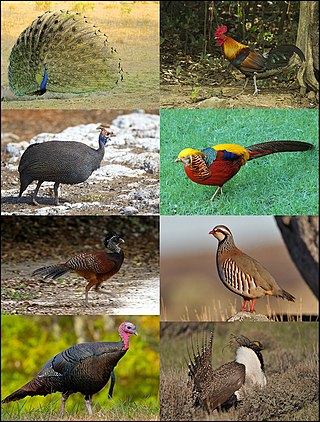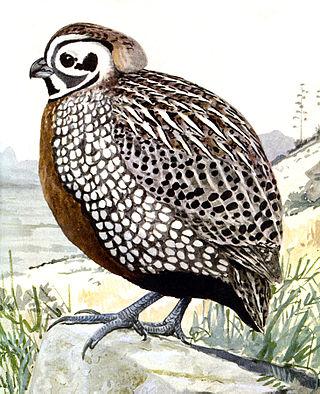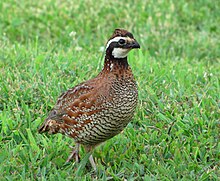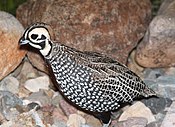
The northern bobwhite, also known as the Virginia quail or bobwhite quail, is a ground-dwelling bird native to Canada, the United States, Mexico, and Cuba, with introduced populations elsewhere in the Caribbean, Europe, and Asia. It is a member of the group of species known as New World quail (Odontophoridae). They were initially placed with the Old World quail in the pheasant family (Phasianidae), but are not particularly closely related. The name "bobwhite" is an onomatopoeic derivation from its characteristic whistling call. Despite its secretive nature, the northern bobwhite is one of the most familiar quails in eastern North America, because it is frequently the only quail in its range. Habitat degradation has contributed to the northern bobwhite population in eastern North America declining by roughly 85% from 1966 to 2014. This population decline is apparently range-wide and continuing.

Quail is a collective name for several genera of mid-sized birds generally placed in the order Galliformes. The collective noun for a group of quail is a flock, covey, or bevy.

A partridge is a medium-sized galliform bird in any of several genera, with a wide native distribution throughout parts of Europe, Asia and Africa. Several species have been introduced to the Americas. They are sometimes grouped in the Perdicinae subfamily of the Phasianidae. However, molecular research suggests that partridges are not a distinct taxon within the family Phasianidae, but that some species are closer to the pheasants, while others are closer to the junglefowl.

Galliformes is an order of heavy-bodied ground-feeding birds that includes turkeys, chickens, quail, and other landfowl. Gallinaceous birds, as they are called, are important in their ecosystems as seed dispersers and predators, and are often reared by humans for their meat and eggs, or hunted as game birds.

The Phasianidae are a family of heavy, ground-living birds, which includes pheasants, partridges, junglefowl, chickens, turkeys, Old World quail, and peafowl. The family includes many of the most popular gamebirds. The family is a large one and includes 185 species divided into 54 genera. It was formerly broken up into two subfamilies, the Phasianinae and the Perdicinae. However, this treatment is now known to be paraphyletic and polyphyletic, respectively, and more recent evidence supports breaking it up into two subfamilies: Rollulinae and Phasianinae, with the latter containing multiple tribes within two clades. The New World quail (Odontophoridae) and guineafowl (Numididae) were formerly sometimes included in this family, but are now typically placed in families of their own; conversely, grouse and turkeys, formerly often treated as distinct families, are now known to be deeply nested within Phasianidae, so they are now included in the present family.

The sand partridge is a gamebird in the pheasant family Phasianidae of the order Galliformes, gallinaceous birds.

The crested partridge also known as the crested wood partridge, roul-roul, red-crowned wood partridge, green wood quail or green wood partridge is a gamebird in the pheasant family Phasianidae of the order Galliformes, gallinaceous birds. It is the only member of the genus Rollulus.

Perdix is a genus of Galliform gamebirds known collectively as the 'true partridges'. These birds are unrelated to the subtropical species that have been named after the partridge due to similar size and morphology.

The king quail, also known as the blue-breasted quail, Asian blue quail, Chinese painted quail, or Chung-Chi, is a species of Old World quail in the family Phasianidae. This species is the smallest "true quail", ranging in the wild from southern China, South and Southeast Asia to Oceania, south to southeastern Australia, with 9 different subspecies. A failed attempt was made to introduce this species to New Zealand by the Otago Acclimatisation Society in the late 1890s. It is quite common in aviculture worldwide, where it is sometimes misleadingly known as the "button quail", which is the name of an only very distantly related family of birds, the buttonquails.

Crested arguses are large and spectacular peafowl-like birds in the genus Rheinardia of the pheasant family.

The Montezuma quail is a stubby, secretive New World quail of Mexico and some nearby parts of the United States. It is also known as Mearns's quail, the harlequin quail, and the fool quail.

The blue quail or African blue quail is a species of bird in the family Phasianidae found in sub-Saharan Africa.

The bearded wood partridge is a bird species in the family Odontophoridae, the New World quail. It inhabits the Sierra Madre Oriental of Mexico.

The crimson-headed partridge is a species of bird in the pheasant, partridge, and francolin family Phasianidae. Described by the British ornithologist Richard Bowdler Sharpe in 1879, it is the only species in the genus Haematortyx. It is endemic to Borneo, where it inhabits lower montane forest in the northern and central parts of the island. It is mainly found at elevations of 1,000–1,700 m (3,300–5,600 ft), but can be seen as low as 185 m (607 ft) and as high as 3,050 m (10,010 ft). Adult males have a striking appearance, with a dark blackish body and crimson red heads, necks, breasts, and undertail coverts. Females have a similar pattern, but with duller brownish-black colouration, orangish-red heads and breasts, and a brownish-black bill instead of a yellowish one. Juveniles are duller and have the crimson restricted to the top of the head.

The spot-winged wood quail is a species of bird in the family Odontophoridae. It is found in Brazil, Argentina and Paraguay, and formerly in Uruguay. In Portuguese and Spanish the bird is called uru.

The black-eared wood quail is a bird species in the order Galliformes. Until recently, the species was thought to be part of the family Phasianidae however DNA-DNA hybridization results determined that black-eared wood quail are only distantly related to Old World quail. As a result, black-eared wood quail have been placed in the family Odontophoridae and more specifically, in the category of wood quail.

The banded quail is a species of bird in the family Odontophoridae. It is found only in Mexico where its natural habitats are subtropical or tropical dry forests, subtropical or tropical dry shrubland, subtropical or tropical high-altitude shrubland, and heavily degraded former forest.

The spot-bellied bobwhite is a ground-dwelling bird in the New World quail family. It is sometimes considered to be conspecific with the crested bobwhite, Colinus cristatus. As the latter species expands north into Costa Rica, it is likely that the two species will overlap in range in the future, but the Costa Rican subspecies of the spot-bellied is the least similar to the crested.

Old World quail is a collective name for several genera of mid-sized birds in the tribe Coturnicini of the pheasant family Phasianidae. Although all species commonly referred to as "Old World quail" are in the same tribe, they are paraphyletic with respect to the other members of the tribe, such as Alectoris, Tetraogallus, Ammoperdix, Margaroperdix, and Pternistis.



























